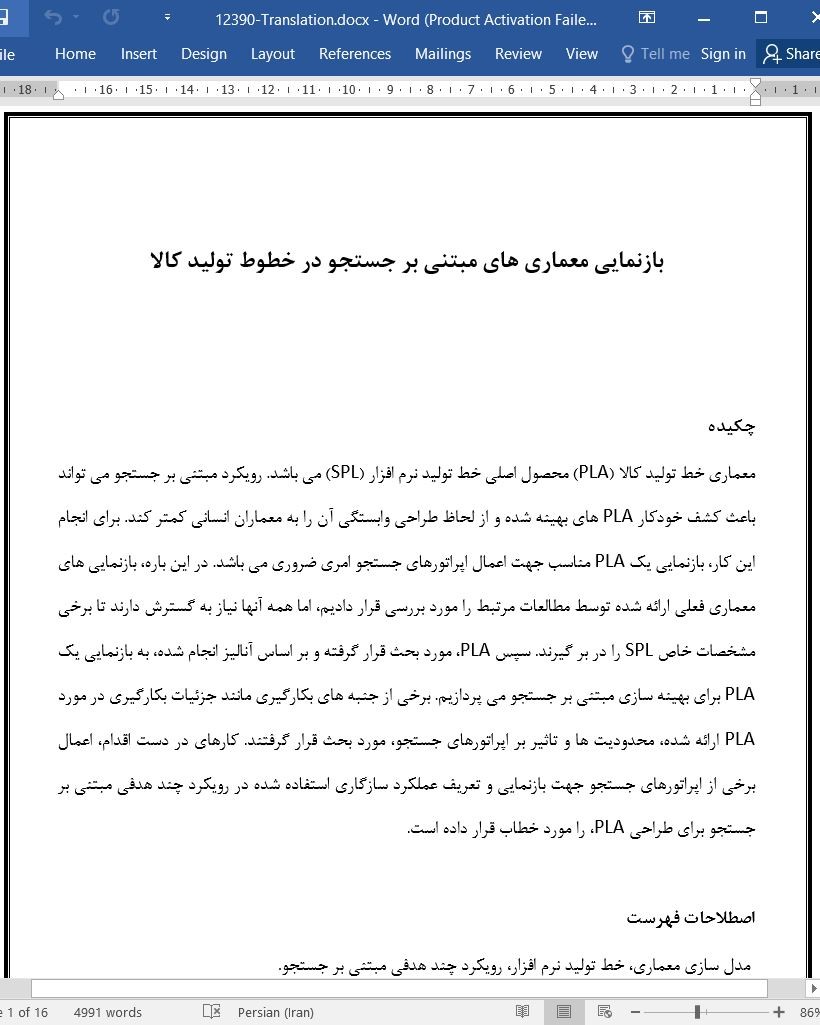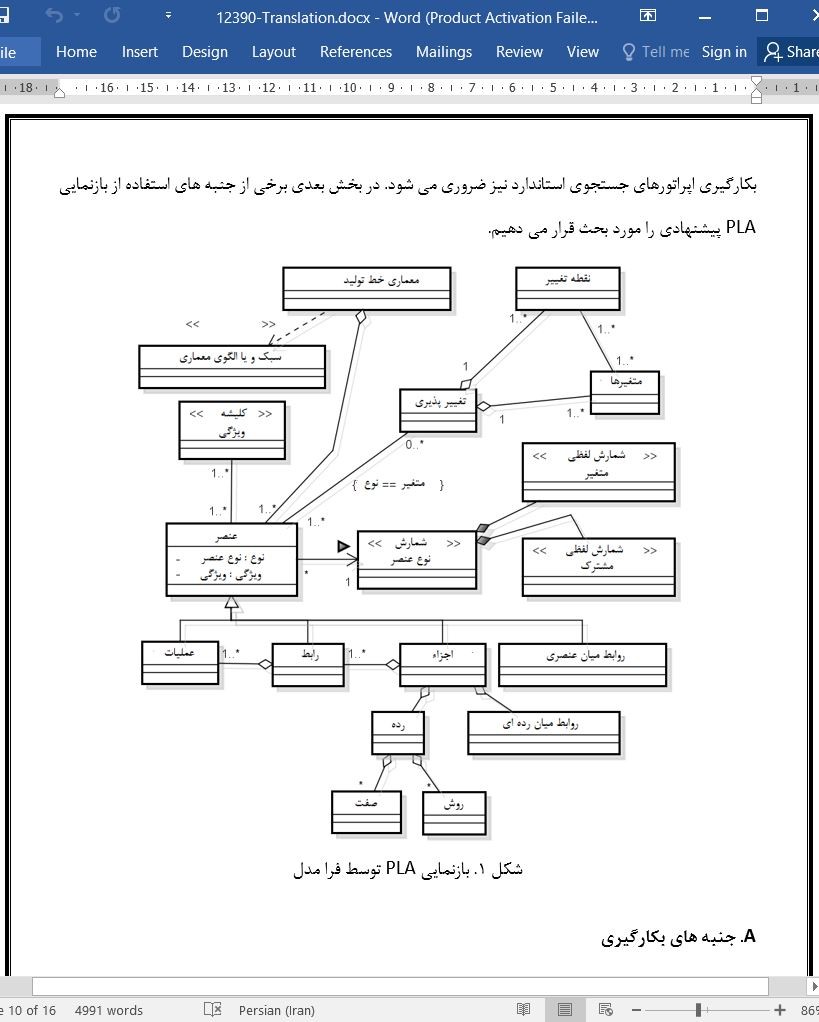
بازنمایی معماری های مبتنی بر جستجو در خطوط تولید کالا
چکیده
معماری خط تولید کالا (PLA) محصول اصلی خط تولید نرم افزار (SPL) می باشد. رویکرد مبتنی بر جستجو می تواند باعث کشف خودکار PLA های بهینه شده و از لحاظ طراحی وابستگی آن را به معماران انسانی کمتر کند. برای انجام این کار، بازنمایی یک PLA مناسب جهت اعمال اپراتورهای جستجو امری ضروری می باشد. در این باره، بازنمایی های معماری فعلی ارائه شده توسط مطالعات مرتبط را مورد بررسی قرار دادیم، اما همه آنها نیاز به گسترش دارند تا برخی مشخصات خاص SPL را در بر گیرند. سپس PLA، مورد بحث قرار گرفته و بر اساس آنالیز انجام شده، به بازنمایی یک PLA برای بهینه سازی مبتنی بر جستجو می پردازیم. برخی از جنبه های بکارگیری مانند جزئیات بکارگیری در مورد PLA ارائه شده، محدودیت ها و تاثیر بر اپراتورهای جستجو، مورد بحث قرار گرفتند. کارهای در دست اقدام، اعمال برخی از اپراتورهای جستجو جهت بازنمایی و تعریف عملکرد سازگاری استفاده شده در رویکرد چند هدفی مبتنی بر جستجو برای طراحی PLA، را مورد خطاب قرار داده است.
1. مقدمه
یک خط تولید نرم افزار (SPL) تشکیل شده از دارایی هایی می باشد که دارای ویژگی های مشترک و متغیر هستند (1). ویژگی ها صفت های یک نرم افزار می باشند که مصرف کننده آخر را مستقیما تحت تاثیر قرار داده و در مدل ویژگی ها ارائه می شوند. یک محصول SPL با ترکیبی از ویژگی های آن ارائه می شود.
چندین مورد از تولیدات SPL می توانند از مزایای رویکردهای مبتنی بر جستجو بهره مند شوند. طراحی معماری های خطوط تولید کالا یکی از آن موارد است. PLA ها مستلزم طراحی می باشند که میان تمامی محصولات نشات گرفته از SPL مشترک باشد (1). طراحی PLA می بایست دربرگیرنده تمامی مولفه هائی که در یک حوزه به ویژگیهای الزامی و متغیر تحقق می بخشند باشد (2). بنابراین PLA یک دارائی کلیدی در مهندسی SPL می باشد زیرا اجازه استفاده مجدد را در مقیاس کلان می دهد. تمرکز این مقاله بر روی طراحی PLA های بازنمایی شده در نمودارهای رده UML می باشد، زیرا این نوع از مدل ها معمولا برای ساختن مدلهای دقیق معماری نرم افزار استفاده می شود (3).
5. نتیجه گیری
در این مقاله، موارد استفاده از بازنمایی های موجود ارائه شده در زمینه PLA را آنالیز کردیم. از تحلیل انجام شده دریافتیم که هر دو نوع بازنمایی، مستقیم و یا از طریق نقشه برداری ژنوتیپ-فنوتیپ، اشاره بر بکارگیری اپراتورهای جستجوی خاص بوده و بازنمایی های موجود به منظور اعمال بر طراحی های PLA مبتنی بر جستجو احتیاج به سازگار شدن دارند. بنابراین، به معرفی یک بازنمایی مستقیم جدید برای اعمال رویکردهای مبتنی بر جستجو بر طراحی PLA پرداختیم، زیرا آسان تر بوده و بکارگیری اپراتورهای خاص جستجو را آسان تر می کند. ما همچنین برخی از جنبه های بکارگیری بازنمایی پیشنهادی را مورد بحث قرار دادیم.
Abstract
The Product-Line Architecture (PLA) is the main artifact of a Software Product Line (SPL). Search-based approaches can provide automated discovery of near-optimal PLAs and make its design less dependent on human architects. To do this, it is necessary to adopt a suitable PLA representation to apply the search operators. In this sense, we review existing architecture representations proposed by related work, but all of them need to be extended to encompass specific characteristics of SPL. Then, the use of such representations for PLA is discussed and, based on the performed analysis, we introduce a novel direct PLA representation for search-based optimization. Some implementation aspects are discussed involving implementation details about the proposed PLA representation, constraints and impact on specific search operators. Ongoing work addresses the application of specific search operators for the proposed representation and the definition of a fitness function to be applied in a multi-objective search-based approach for the PLA design.
I. INTRODUCTION
A Software Product Line (SPL) is comprised by core assets that have explicit common and variable features [1]. Features are attributes of a software system that affect directly the final users and they are usually represented in feature models. A product of the SPL is given by a combination of its features.
Several SPL development activities can be benefitted by search-based approaches. The design of software Product Line Architectures (PLAs) is one of them. PLAs entail a design that is common to all the products derived from the SPL [1]. The design of a PLA should encompass the components realizing all the mandatory and varying features in a domain [2]. So, a PLA is a key asset in SPL Engineering since it allows the large-scale reuse. The focus of this work is the PLA design, represented by UML class diagrams, since this kind of model is commonly used to model software architectures in the detailed level [3].
V. CONCLUDING REMARKS
In this paper we analysed the use of existing architecture representations proposed in the literature for the PLA context. From the performed analysis we conclude that both representations, direct and through genotype-phenotype mapping, imply on the implementation of specific search operators and the existing representations need to be adapted to be applied in the search-based PLA design. So, we introduced a novel direct PLA representation for the application of search-based approaches to the PLA design since it is more natural and makes the implementation of specific search operators easier. We also discussed some implementation aspects regarding the proposed representation.
چکیده
1. مقدمه
2. بازنمایی های معماری: مروری بر متون مبتنی بر جستجو
A. نقشه برداری ژنوتیپ-فنوتیپ
B. بازنمایی مستقیم
3. تحلیلی در رابطه با طراحی PLA
4. بازنمایی PLA پیشنهادی
A. جنبه های بکارگیری
5. نتیجه گیری
منابع
Abstract
.1 INTRODUCTION
2. ARCHITECTURE REPRESENTATIONS: A REVIEW IN THE SEARCH-BASED CONTEXT
A. Genotype-Phenotype Mapping
B. Direct Representation
3. AN ANALYSIS CONSIDERING PLA DESIGN
4. THE PROPOSED PLA REPRESENTATION
A. Implementation Aspects
5. CONCLUDING REMARKS
REFERENCES
- اصل مقاله انگلیسی با فرمت ورد (word) با قابلیت ویرایش
- ترجمه فارسی مقاله با فرمت ورد (word) با قابلیت ویرایش، بدون آرم سایت ای ترجمه
- ترجمه فارسی مقاله با فرمت pdf، بدون آرم سایت ای ترجمه



